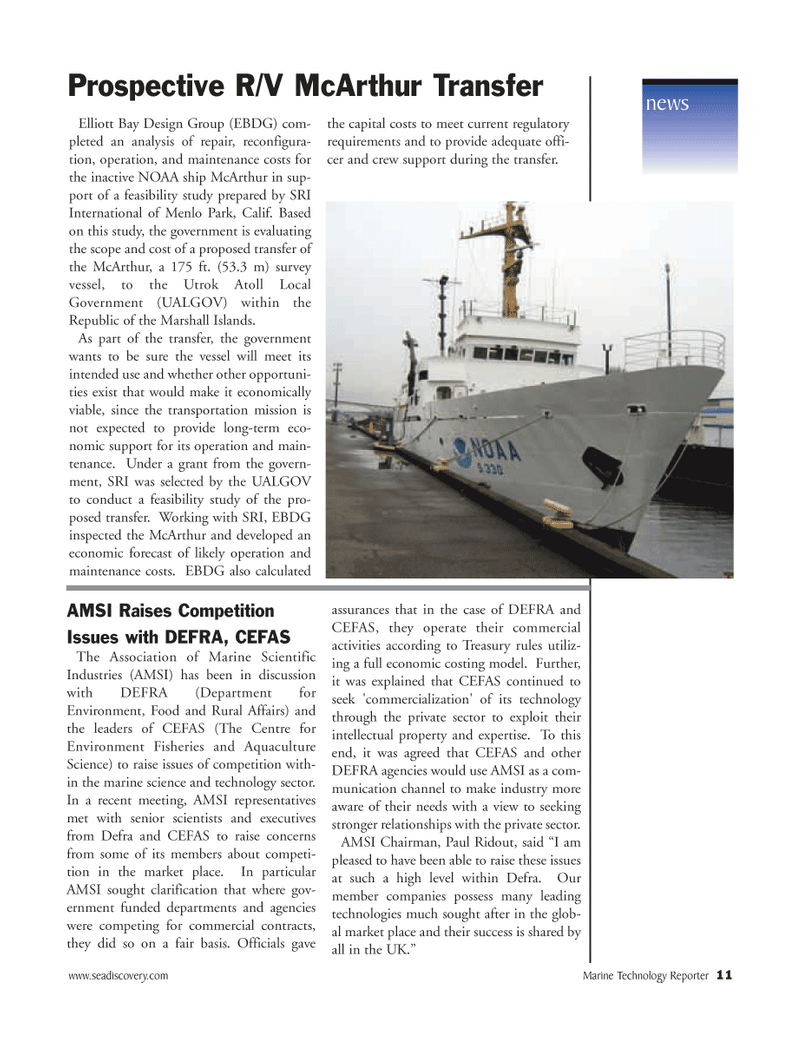
Page 11: of Marine Technology Magazine (November 2005)
Seafloor Engineering
Read this page in Pdf, Flash or Html5 edition of November 2005 Marine Technology Magazine
www.seadiscovery.com Marine Technology Reporter 11
Elliott Bay Design Group (EBDG) com- pleted an analysis of repair, reconfigura- tion, operation, and maintenance costs for the inactive NOAA ship McArthur in sup- port of a feasibility study prepared by SRI
International of Menlo Park, Calif. Based on this study, the government is evaluating the scope and cost of a proposed transfer of the McArthur, a 175 ft. (53.3 m) survey vessel, to the Utrok Atoll Local
Government (UALGOV) within the
Republic of the Marshall Islands.
As part of the transfer, the government wants to be sure the vessel will meet its intended use and whether other opportuni- ties exist that would make it economically viable, since the transportation mission is not expected to provide long-term eco- nomic support for its operation and main- tenance. Under a grant from the govern- ment, SRI was selected by the UALGOV to conduct a feasibility study of the pro- posed transfer. Working with SRI, EBDG inspected the McArthur and developed an economic forecast of likely operation and maintenance costs. EBDG also calculated the capital costs to meet current regulatory requirements and to provide adequate offi- cer and crew support during the transfer.
Prospective R/V McArthur Transfer news
AMSI Raises Competition
Issues with DEFRA, CEFAS
The Association of Marine Scientific
Industries (AMSI) has been in discussion with DEFRA (Department for
Environment, Food and Rural Affairs) and the leaders of CEFAS (The Centre for
Environment Fisheries and Aquaculture
Science) to raise issues of competition with- in the marine science and technology sector.
In a recent meeting, AMSI representatives met with senior scientists and executives from Defra and CEFAS to raise concerns from some of its members about competi- tion in the market place. In particular
AMSI sought clarification that where gov- ernment funded departments and agencies were competing for commercial contracts, they did so on a fair basis. Officials gave assurances that in the case of DEFRA and
CEFAS, they operate their commercial activities according to Treasury rules utiliz- ing a full economic costing model. Further, it was explained that CEFAS continued to seek 'commercialization' of its technology through the private sector to exploit their intellectual property and expertise. To this end, it was agreed that CEFAS and other
DEFRA agencies would use AMSI as a com- munication channel to make industry more aware of their needs with a view to seeking stronger relationships with the private sector.
AMSI Chairman, Paul Ridout, said “I am pleased to have been able to raise these issues at such a high level within Defra. Our member companies possess many leading technologies much sought after in the glob- al market place and their success is shared by all in the UK.”
MTR#3 (1-16).qxd 11/15/2005 2:13 PM Page 13

 10
10

 12
12
